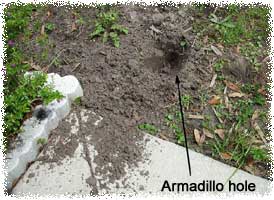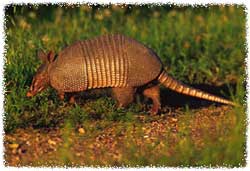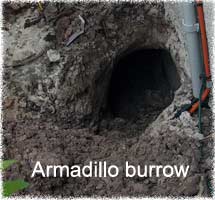Armadillo, Raccoon & Cat Live Trap
Single Door Rigid Live Trap, Model 108, is a great trap for catching those anoying Armadillos, raccoons, opossums, rabbits, groundhogs, armadillos, feral cats and lots of other medium sized animals
- Size = 32" x 10" x 12"
- Grid Construction = 1" x 2"
- Gauge = 12
- Weight = 16 lbs
 These traps feature a sturdy frame that is constructed of heavy 12, 14, or 16 gauge galvanized steel wire mesh (depending upon model) for maximum resistance to rust and corrosion. An open fabric construction allows the animals to see through the trap in all directions and enter the trap with confidence. Galvanized steel rods are welded to the wire mesh frame for extra support and reinforcement. A spring loaded, automatic locking V-door, securely and safely traps the animal inside the trap immediately after the animal steps onto the trip pan, located at the back of the trap. Galvanized 1/2 by 1/2 inch wire mesh openings are welded to the bait areas to prevent animals from reaching through the outside of the trap. A super fast spring loaded door eliminates the chance of the animal backing out of the trap before the door springs shut and locks into place. The special locking system and the heavy reinforcement of the trap doors prohibits animals from forcing the door open, even if the animals manages to turn the trap upside down. This makes these traps perform well when trapping animals at any angle. Deluxe Single Door Rigid Live Traps are also equipped with an adjustable trigger release mechanism that allows for heavy or light sets. Most of these traps include a protective piece of galvanized sheet under the safety handle of the trap, to protect the trapper against scratches from the trapped animal. The deluxe single door traps a variety of different sized animals, ranging from rat to large dog.
These traps feature a sturdy frame that is constructed of heavy 12, 14, or 16 gauge galvanized steel wire mesh (depending upon model) for maximum resistance to rust and corrosion. An open fabric construction allows the animals to see through the trap in all directions and enter the trap with confidence. Galvanized steel rods are welded to the wire mesh frame for extra support and reinforcement. A spring loaded, automatic locking V-door, securely and safely traps the animal inside the trap immediately after the animal steps onto the trip pan, located at the back of the trap. Galvanized 1/2 by 1/2 inch wire mesh openings are welded to the bait areas to prevent animals from reaching through the outside of the trap. A super fast spring loaded door eliminates the chance of the animal backing out of the trap before the door springs shut and locks into place. The special locking system and the heavy reinforcement of the trap doors prohibits animals from forcing the door open, even if the animals manages to turn the trap upside down. This makes these traps perform well when trapping animals at any angle. Deluxe Single Door Rigid Live Traps are also equipped with an adjustable trigger release mechanism that allows for heavy or light sets. Most of these traps include a protective piece of galvanized sheet under the safety handle of the trap, to protect the trapper against scratches from the trapped animal. The deluxe single door traps a variety of different sized animals, ranging from rat to large dog.
If storage space is a concern, Model 108 is also available as a collapsible trap, Model 207, and as a transfer trap with a rear sliding door, Model 608. The rear sliding door is HIGHLY recommended because it makes baiting and releasing the animal much easier.
Collapsible Trap, Model 207, is the perfect alternative when storage space is a concern.
Model 608 has the added benefit of having a rear release door. This addition makes Model 608 a must-have for catching cats and rabbits.


General Armadillo Information - When drought conditions arrive on the scene, so do armadillos. The
armadillo is a nocturnal creature that feeds on insects, earthworms, grubs and
other subterranean delicacies that it finds on the menu.
The armadillo
prefers dense, shady cover such as brush, woodlands, forests, and areas adjacent
to creeks and rivers. Soil texture is also a factor in the animal's habitat
selection. It prefers sandy or loam soils that are loose and porous.
The armadillo will also inhabit areas having cracks, crevices, and
rocks that are suitable for burrows.
Most armadillo
damage occurs as a result of their rooting in lawns, golf courses, vegetable
gardens, and flower beds. Characteristic signs of armadillo activity are shallow
holes, 1 to 3 inches deep and 3 to 5 inches wide, which are dug in search of
food. They also uproot flowers and other ornamental plants. Some damage has been
caused by their burrowing under foundations, driveways, and other structures.
Some people complain that armadillos keep them awake at night by rubbing their
shells against their houses or other structures.

You will want to begin by removing the armadillos that are creating lawn and landscape damage.
Armadillos can damage a large area overnight and will continue to feed in the
area until the source of food is depleted.
Dry weather and wet
flower beds all add up for armadillo attacks and destruction in the suburbs.
How to Trap an Armadillo - Many subtleties go into armadillo trapping - the path of the animal, what direction it will be traveling, and most of all, its behavior and reaction to a trap. The right sized trap must be used - preferably a large cage trap at least 12 x 10 x 30, meant for raccoons and other large animals. Armadillos can be very tough, so the trap must be sturdy. As stated, the armadillo will not enter a trap for any kind of food. Don't listen to lame advice on baits - rotting bananas, cabbage, nylon stockings filled with earthworms, these are all completely ineffective. As usual, if you don't believe me, give them a try and see how they fail. In fact, if you do bait the trap, you're likely to lure in a non-target animal such as an opossum or a raccoon. No bait is ever necessary for trapping armadillos. All you have to do is force the animal to walk into the trap. First, find out where it will be walking - along edges, near its burrow. Then set the trap along that path, and use directional barriers - planks of wood, fences, concrete blocks, that will effectively funnel the poor-sighted dim-witted armadillo into the trap. If the trap is sturdy and inviting with nice dirt lining the bottom, the armadillo will simply walk in, and you have him!
Some General Raccoon Information - Raccoons breed mainly in February and March with a gestation period of 63 days. Adult males travel within areas of about 3 to 8 square miles, compared to about 1 to 3 square miles for females.
What Damage to raccoons do?
The different types of damage which raccoons are capable of are almost too numerous to mention. In urban environments, raccoons are more than capable of finding homes in uncapped chimneys. tearing off shingles or fascia in order to gain entrance to an attic or wall void, tearing up lawns in search for grubs and earthworms, destroying gardens, and upsetting and eating the contents of garbage cans. In attics and wall voids, the build-up of raccoon feces and urine can constitute health hazards to the homeowner. In more rural environments, raccoons can be highly destructive in and around poultry barns.
What bait should I use for raccoons?
Fish, fresh or canned, honey or sugar covered vegetables, smoked fish, watermelon, sweet corn, cooked fatty meat, crisp bacon. Special favorite of the raccoon is marshmallows!
Where should I place raccoons traps?
Locate the trap in an area where raccoons are often observed. Place the trap on a level surface. Since raccoons tend to dig all the dirt up under the trap, place the trap on a flat piece of wood. Dispose of the wood after the raccoon is caught. Position one side of the trap against a wall of a building or in a path commonly traveled by raccoons. Before handling the trap, you may want to spray with an insecticide because they often have fleas and ticks. Wear sturdy gloves to cover your hands, since raccoons and skunks carry many diseases. If there are known cases of rabies in your area, we suggest that you contact a professional animal removal service.
